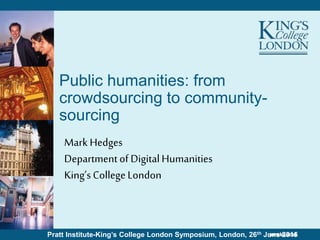
Public humanities: from crowdsourcing to community-sourcing
- 1. Pratt Institute-King’s College London Symposium, London, 26th June 2015 Public humanities: from crowdsourcing to community- sourcing Mark Hedges Departmentof DigitalHumanities King’s CollegeLondon
- 3. 3 Definitions of crowdsourcing [I]t doesn’t matter where the laborers are – they might be down the block, they might be in Indonesia – as long as they are connected to the network … the labor isn’t always free, but it costs a lot less than paying traditional employees. It’s not outsourcing; it’s crowdsourcing. [Howe 2006]
- 4. 4 [A] hybrid model that blends the transparent and democratizing elements of open source into a feasible model for doing profitable business, all facilitated through the web [Brabham 2008] Definitions of crowdsourcing
- 5. 5 Definitions of crowdsourcing Most successful crowdsourcing projects are not about large anonymous masses of people. ... They are about inviting participation from interested and engaged members of the public. These projects can continue a long standing tradition of volunteerism and involvement of citizens in the creation and continued development of public goods [Owens 2012] [T]he process of leveraging public participation in or contributions to projects and activities. [Dunn and Hedges 2012]
- 6. 6 The Business of Crowdsourcing
- 7. 7 Crowdsourcing as Business: MTurk Example tasks: • Tagging images • Subtitling (speech -> text) • OCR correction • CAPTCHA cracking • ...
- 9. 9 Academic Crowdsourcing in the Humanities
- 10. 10 A schematic view Asset Process Output Task
- 11. 11 Models of Engagement Amazon MTurk: • Open recruitment • Generic (or no) interest • Micropayment • Engagement? • Community? • Open recruitment • Broad interest (initially) • Various rewards • Increased engagement • Loose/multiple communities • Some central support • Focused recruitment • Very specific interest/expertise • Close engagement • Close community • Strong central support Academic crowdsourcing models
- 12. 12
- 13. 13
- 14. 14 Motivations • Not financial (they are not being paid) • Intrinsic interest it the subject matter (or process): • Broad/general interest • Specific/personal interest • Opportunity to share interest with others • More extrinsic: • Wish to contribute to something worthwhile • (Benign) competition • “social” rewards: rankings, standing in the community, credited in publications
- 15. 15 Specialist knowledge Size of ‘the crowd’ Collaborative tagging Cataloguing Levels of Expertise
- 16. 16 ‘Super-contributors’ and the long tail Small number of contributors do many transcriptions Large number of participants do small number of transcriptions
- 17. 17
- 18. 18 Groups form around a: • Topic • Subset of the source assets • Practice/activity Roles develop as result of: • Activities undertaken • Expertise and interests • Conscious decision Self-organisation vs top-down Peer production of research Self-organisation and ‘Peer Production’
- 19. 19 Communities and Quality (Assurance) • Perceived potential for low quality of crowdsourced info: • Professional (expert?) vs amateur • e.g. criticisms of Wikipedia • Automated QA: • e.g. replication of tasks, comparison of results • Assumes measurable correctness • Community-based, collaborative QA: • Via collaboration and discussion • Importance of clear criteria
- 20. 20
- 21. 21
- 22. 22 Community knowledge creation Communities can provide very specific contributions: • Interests and enthusiasms: • e.g. maps, family history • Specific (unique) objects/artefacts: • e.g. ephemera, photographs, diaries • Knowledge/Information: • e.g. about family members, places • Experience/expertise: • e.g. relating to former occupation
- 27. 27 Outcomes for participants • Creation of communities • Communities forming around question/topic • Technical/practical skills: • ICT skills (e.g. wiki editing), paleography • Domain knowledge: • e.g. about family members, places • Specialised research skills: • Text editing, paleography, collaborative projects
- 28. 28 To sum up … • Communities rather than crowds • Self-organisation rather than hierarchy • Engagement rather than anonymity • Collaboration rather than independence
